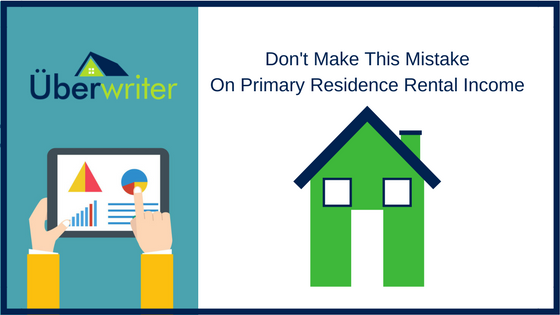Over the last few days we have been putting the final touches on our 2018 underwriting training courses launching March 2nd. While I was reviewing the rental income course I realized we did not provide enough information in one key area. There is a difference for rental income generated from a primary residence on a conventional loan versus a rental property. To make sure we keep our training the best on the market, we created additional content for the training library just for this topic.
Training Library Update
Our audit reviews show most underwriters properly interpret FNMA/FHLMC guidelines on when you can use income for a primary residence which is:
- When the primary is a 2-4 unit
- When the primary is a SFR and meets the “live in aide” requirement
- SFR when as a compensating factor on programs such as FNMA Home Ready
The error we find, and why we felt it was important to create the additional training video, is in the math. When reviewing files in audit we have seen underwriters using the same method used on investment properties to credit the borrower with the rental income. But that is not the proper method, let me demonstrate the subtle difference that can make or break a files DTI.
First you follow the standard rental income guidelines and determine if you are going to use Schedule E or a lease. Then calculate the gross rental income based on the method, this is where you stop. If you if you complete the next step, which is to subtract the PITI from that gross rental you will make an error. Look at this example below based on a 2-unit property shown as a primary residence versus a rental property. Keep in mind we used the same rental income of $2,000 just to demonstrate the difference, we understand you would not have the same $2,000 coming in for one unit as you would for two units. The focus here is on the math:
Using A Lease
Primary Residence Vs Investment Property
$2,000 $2,000
X 75% x 75%
= $1,500 = $1,500
N/A $1,000 subtract PITI
$1,500 Net Rental Income $500 Net Rental Income
The reason you don’t subtract the PITI when the rental income is from the primary is the borrower must always be able to afford their own primary residence. Said in another way regardless if you have a renter or not, you must pay the full mortgage. In comparison an investment property we are only considering the net income or loss, not the PITI. For rental income on a primary what ever “net” income you have does not “offset” the PITI but instead is treated more like a second job income (which is just added to the total income) see this chart below on how we “finish” the math!
Primary Residence Vs Investment Property
$5,000 Employment Income $5,000 Employment Income
$1,500 Rental Income $500 Rental Income
$6,500 Total Income $5,500 Total Income
$1500 Primary Residence Payment $1500 Primary Residence Payment
$500 Loans $500 Loans
$2,000 Total Debts $2,000 Total Debts
23.08 / 30.77 Ratios 27.27 / 36.36 Ratios
Hopefully this gives a good picture on the difference between rental income analysis on a primary versus rental income analysis on an investment property.


5 Responses
How about when u convert your exiting residence to a rental property and buy a new primary home
How is the DTI calculated ? For the DTI calculaton , you wont include the converted rental property PITI ? and for income just do the Rent * 75% – PITI
Hi Kiran
When you convert your old primary to an investment, you can now follow the standard rental property rules. The rules noted in the blog would apply only to homes that are still the borrower’s primary residence. Hope that helps!
Mike
Hi Michael, have a scenario for you for this calculation.
– I have a primary residence which I resided in for a couple years.
– I moved in with a girl and decided to Airbnb/VRBO the property (and has done really really well)
– Am I able to use that income to buy another property as a primary residence for my girlfriend and I to live in?
Thanks,
Hi Dan
It is possible based on the requirement of the Airbnb /VRBO income is reported on your 1040 personal return (via the SCH E form). If you do not have this income reported on your 2018/2017 return it might be difficult to use.
Hope that helps!
what’s the “live in aide” requirement